MNG10253 - Sustainability Report: McDonald's Business Analysis
VerifiedAdded on 2022/10/01
|10
|2259
|18
Report
AI Summary
This report analyzes the sustainability practices of McDonald's, focusing on its core business of food and restaurant services. It provides an overview of McDonald's operations, including its global presence and revenue. The report details the food production cycle, outlining inputs, outputs, and potential pollution sources. It identifies major causes of unsustainability, such as the use of non-sustainable resources in packaging, waste generation, and carbon footprint from transport. The report proposes a closed-loop production system, using a cradle-to-cradle design to reduce waste and promote resource efficiency. It suggests improvements in waste water treatment, food waste utilization, and design modifications for production equipment to minimize wastage. The report emphasizes the importance of design improvements and waste management software to achieve sustainability goals. The bibliography provides a list of cited sources.
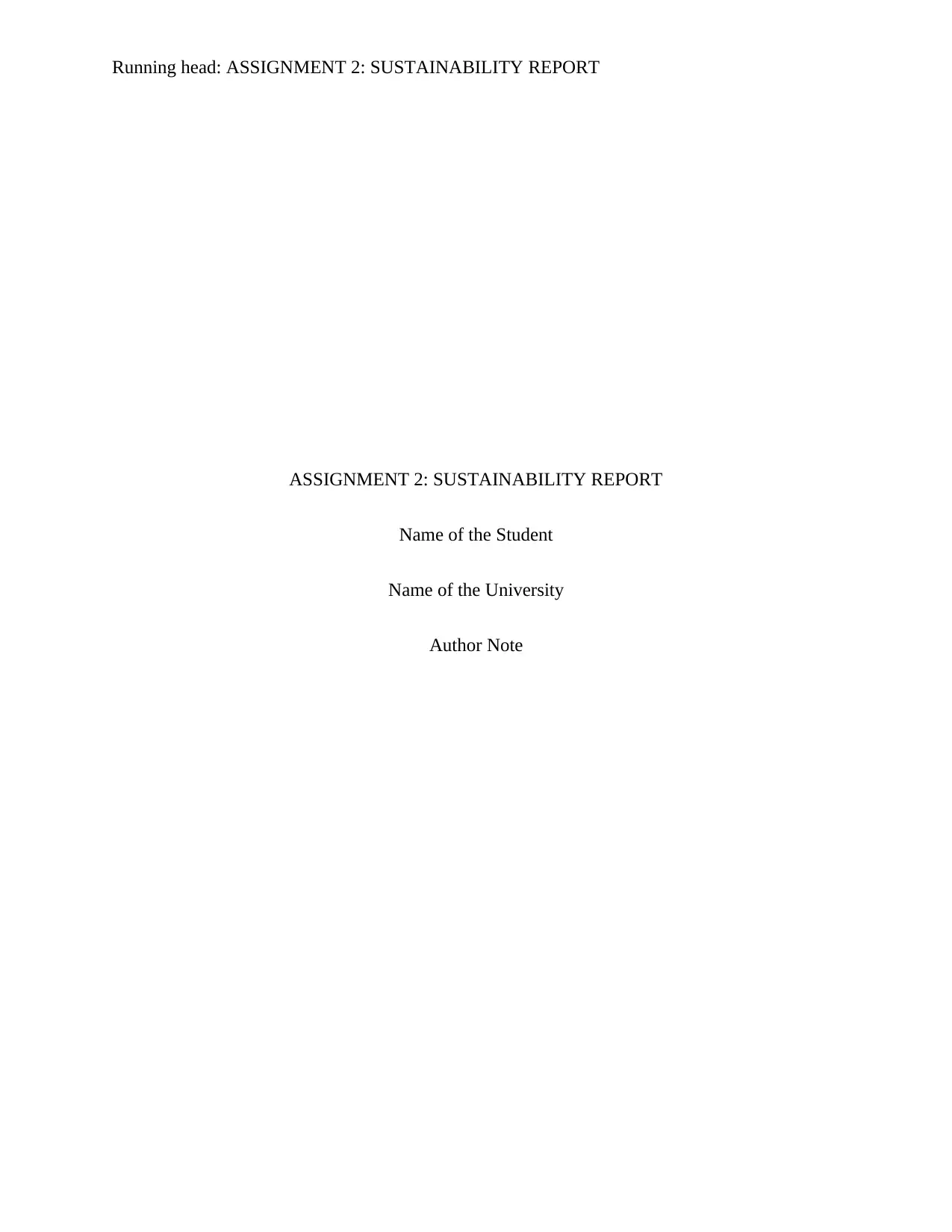
Running head: ASSIGNMENT 2: SUSTAINABILITY REPORT
ASSIGNMENT 2: SUSTAINABILITY REPORT
Name of the Student
Name of the University
Author Note
ASSIGNMENT 2: SUSTAINABILITY REPORT
Name of the Student
Name of the University
Author Note
Paraphrase This Document
Need a fresh take? Get an instant paraphrase of this document with our AI Paraphraser
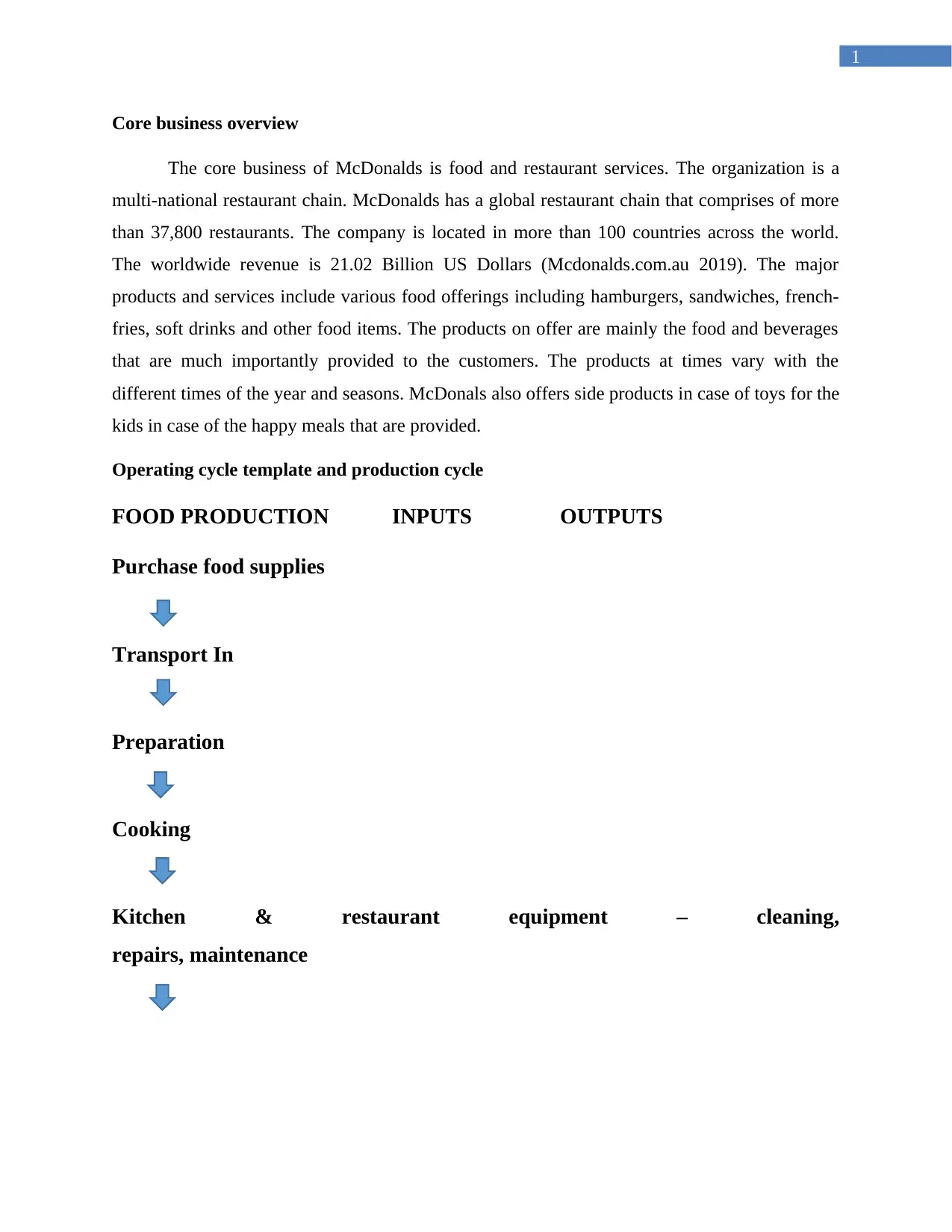
1
Core business overview
The core business of McDonalds is food and restaurant services. The organization is a
multi-national restaurant chain. McDonalds has a global restaurant chain that comprises of more
than 37,800 restaurants. The company is located in more than 100 countries across the world.
The worldwide revenue is 21.02 Billion US Dollars (Mcdonalds.com.au 2019). The major
products and services include various food offerings including hamburgers, sandwiches, french-
fries, soft drinks and other food items. The products on offer are mainly the food and beverages
that are much importantly provided to the customers. The products at times vary with the
different times of the year and seasons. McDonals also offers side products in case of toys for the
kids in case of the happy meals that are provided.
Operating cycle template and production cycle
FOOD PRODUCTION INPUTS OUTPUTS
Purchase food supplies
Transport In
Preparation
Cooking
Kitchen & restaurant equipment – cleaning,
repairs, maintenance
Core business overview
The core business of McDonalds is food and restaurant services. The organization is a
multi-national restaurant chain. McDonalds has a global restaurant chain that comprises of more
than 37,800 restaurants. The company is located in more than 100 countries across the world.
The worldwide revenue is 21.02 Billion US Dollars (Mcdonalds.com.au 2019). The major
products and services include various food offerings including hamburgers, sandwiches, french-
fries, soft drinks and other food items. The products on offer are mainly the food and beverages
that are much importantly provided to the customers. The products at times vary with the
different times of the year and seasons. McDonals also offers side products in case of toys for the
kids in case of the happy meals that are provided.
Operating cycle template and production cycle
FOOD PRODUCTION INPUTS OUTPUTS
Purchase food supplies
Transport In
Preparation
Cooking
Kitchen & restaurant equipment – cleaning,
repairs, maintenance
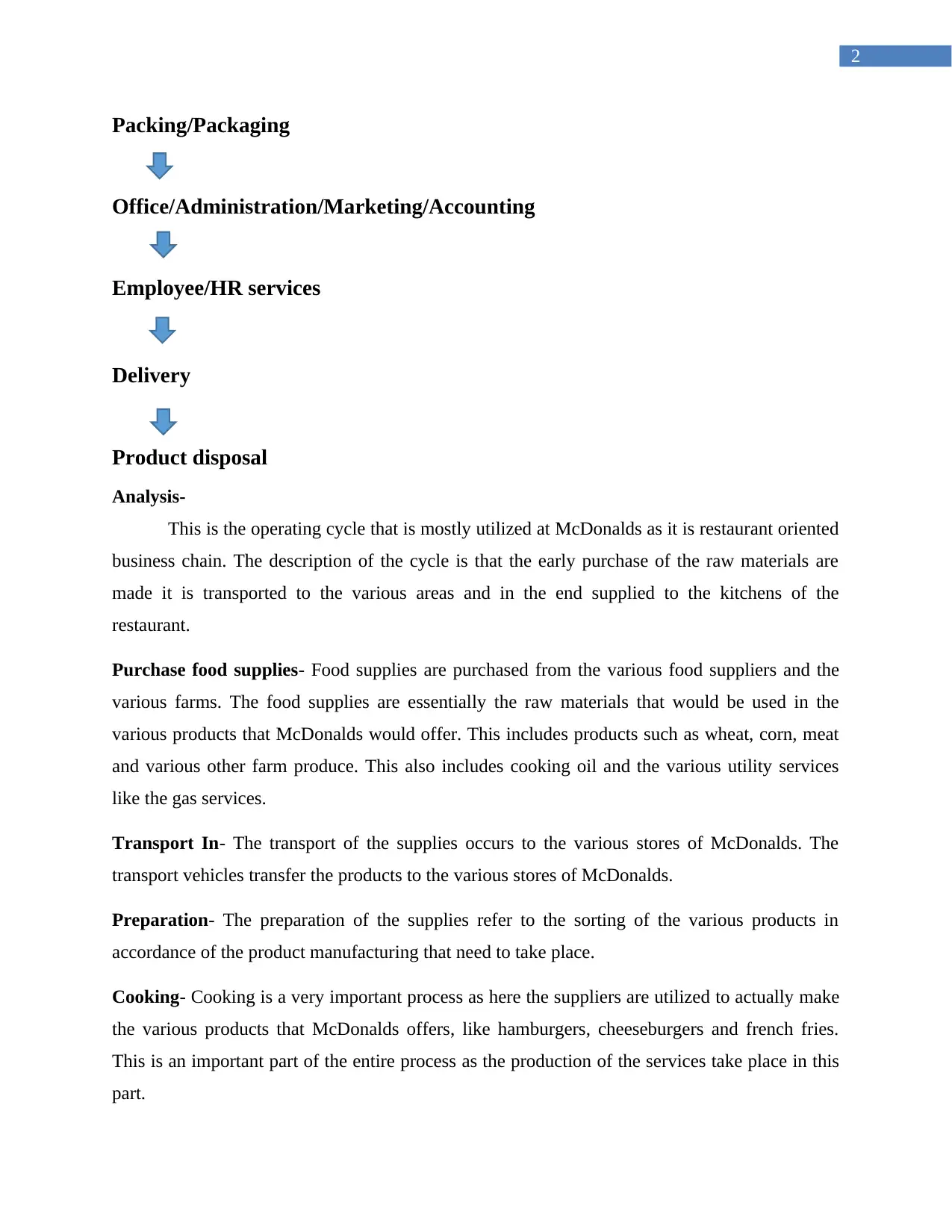
2
Packing/Packaging
Office/Administration/Marketing/Accounting
Employee/HR services
Delivery
Product disposal
Analysis-
This is the operating cycle that is mostly utilized at McDonalds as it is restaurant oriented
business chain. The description of the cycle is that the early purchase of the raw materials are
made it is transported to the various areas and in the end supplied to the kitchens of the
restaurant.
Purchase food supplies- Food supplies are purchased from the various food suppliers and the
various farms. The food supplies are essentially the raw materials that would be used in the
various products that McDonalds would offer. This includes products such as wheat, corn, meat
and various other farm produce. This also includes cooking oil and the various utility services
like the gas services.
Transport In- The transport of the supplies occurs to the various stores of McDonalds. The
transport vehicles transfer the products to the various stores of McDonalds.
Preparation- The preparation of the supplies refer to the sorting of the various products in
accordance of the product manufacturing that need to take place.
Cooking- Cooking is a very important process as here the suppliers are utilized to actually make
the various products that McDonalds offers, like hamburgers, cheeseburgers and french fries.
This is an important part of the entire process as the production of the services take place in this
part.
Packing/Packaging
Office/Administration/Marketing/Accounting
Employee/HR services
Delivery
Product disposal
Analysis-
This is the operating cycle that is mostly utilized at McDonalds as it is restaurant oriented
business chain. The description of the cycle is that the early purchase of the raw materials are
made it is transported to the various areas and in the end supplied to the kitchens of the
restaurant.
Purchase food supplies- Food supplies are purchased from the various food suppliers and the
various farms. The food supplies are essentially the raw materials that would be used in the
various products that McDonalds would offer. This includes products such as wheat, corn, meat
and various other farm produce. This also includes cooking oil and the various utility services
like the gas services.
Transport In- The transport of the supplies occurs to the various stores of McDonalds. The
transport vehicles transfer the products to the various stores of McDonalds.
Preparation- The preparation of the supplies refer to the sorting of the various products in
accordance of the product manufacturing that need to take place.
Cooking- Cooking is a very important process as here the suppliers are utilized to actually make
the various products that McDonalds offers, like hamburgers, cheeseburgers and french fries.
This is an important part of the entire process as the production of the services take place in this
part.
⊘ This is a preview!⊘
Do you want full access?
Subscribe today to unlock all pages.

Trusted by 1+ million students worldwide
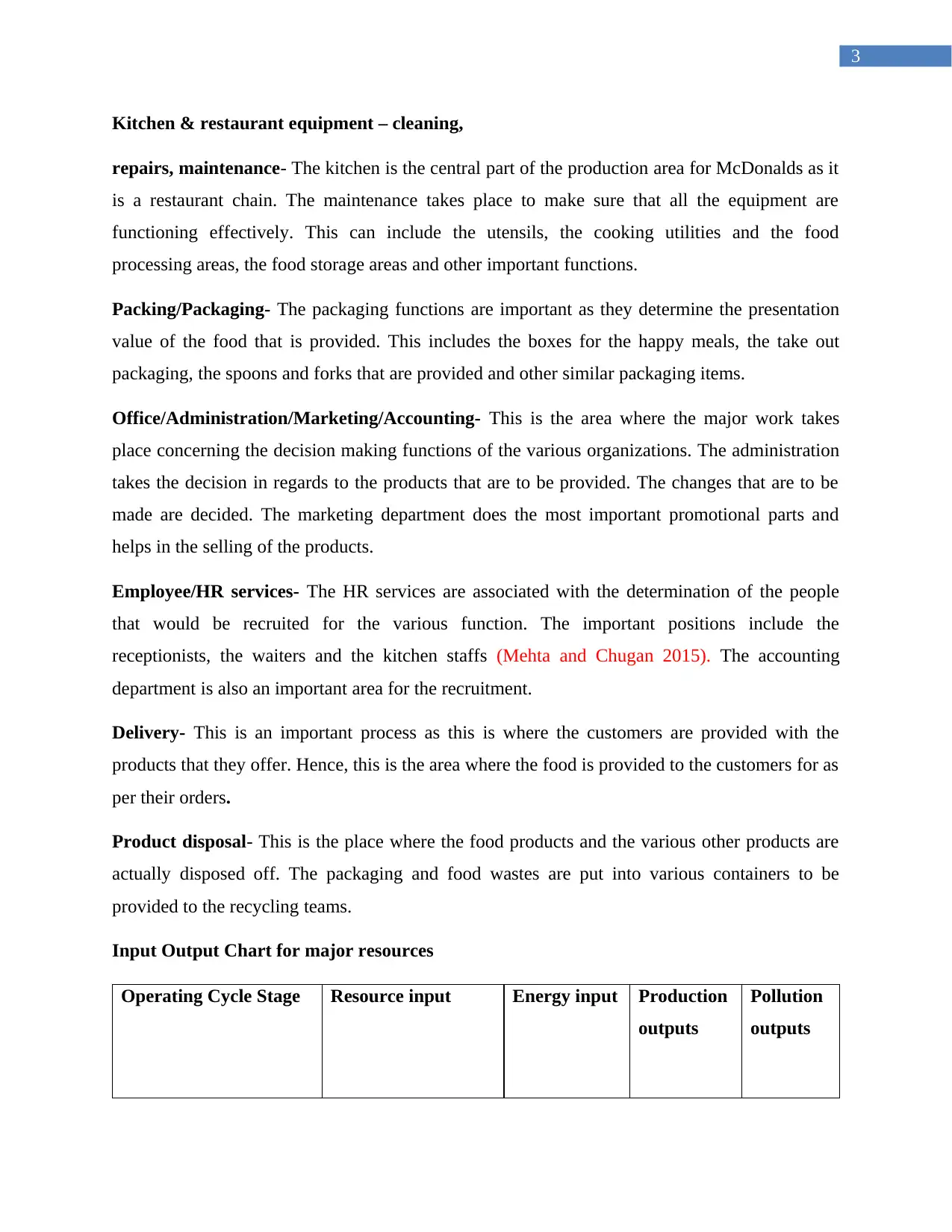
3
Kitchen & restaurant equipment – cleaning,
repairs, maintenance- The kitchen is the central part of the production area for McDonalds as it
is a restaurant chain. The maintenance takes place to make sure that all the equipment are
functioning effectively. This can include the utensils, the cooking utilities and the food
processing areas, the food storage areas and other important functions.
Packing/Packaging- The packaging functions are important as they determine the presentation
value of the food that is provided. This includes the boxes for the happy meals, the take out
packaging, the spoons and forks that are provided and other similar packaging items.
Office/Administration/Marketing/Accounting- This is the area where the major work takes
place concerning the decision making functions of the various organizations. The administration
takes the decision in regards to the products that are to be provided. The changes that are to be
made are decided. The marketing department does the most important promotional parts and
helps in the selling of the products.
Employee/HR services- The HR services are associated with the determination of the people
that would be recruited for the various function. The important positions include the
receptionists, the waiters and the kitchen staffs (Mehta and Chugan 2015). The accounting
department is also an important area for the recruitment.
Delivery- This is an important process as this is where the customers are provided with the
products that they offer. Hence, this is the area where the food is provided to the customers for as
per their orders.
Product disposal- This is the place where the food products and the various other products are
actually disposed off. The packaging and food wastes are put into various containers to be
provided to the recycling teams.
Input Output Chart for major resources
Operating Cycle Stage Resource input Energy input Production
outputs
Pollution
outputs
Kitchen & restaurant equipment – cleaning,
repairs, maintenance- The kitchen is the central part of the production area for McDonalds as it
is a restaurant chain. The maintenance takes place to make sure that all the equipment are
functioning effectively. This can include the utensils, the cooking utilities and the food
processing areas, the food storage areas and other important functions.
Packing/Packaging- The packaging functions are important as they determine the presentation
value of the food that is provided. This includes the boxes for the happy meals, the take out
packaging, the spoons and forks that are provided and other similar packaging items.
Office/Administration/Marketing/Accounting- This is the area where the major work takes
place concerning the decision making functions of the various organizations. The administration
takes the decision in regards to the products that are to be provided. The changes that are to be
made are decided. The marketing department does the most important promotional parts and
helps in the selling of the products.
Employee/HR services- The HR services are associated with the determination of the people
that would be recruited for the various function. The important positions include the
receptionists, the waiters and the kitchen staffs (Mehta and Chugan 2015). The accounting
department is also an important area for the recruitment.
Delivery- This is an important process as this is where the customers are provided with the
products that they offer. Hence, this is the area where the food is provided to the customers for as
per their orders.
Product disposal- This is the place where the food products and the various other products are
actually disposed off. The packaging and food wastes are put into various containers to be
provided to the recycling teams.
Input Output Chart for major resources
Operating Cycle Stage Resource input Energy input Production
outputs
Pollution
outputs
Paraphrase This Document
Need a fresh take? Get an instant paraphrase of this document with our AI Paraphraser
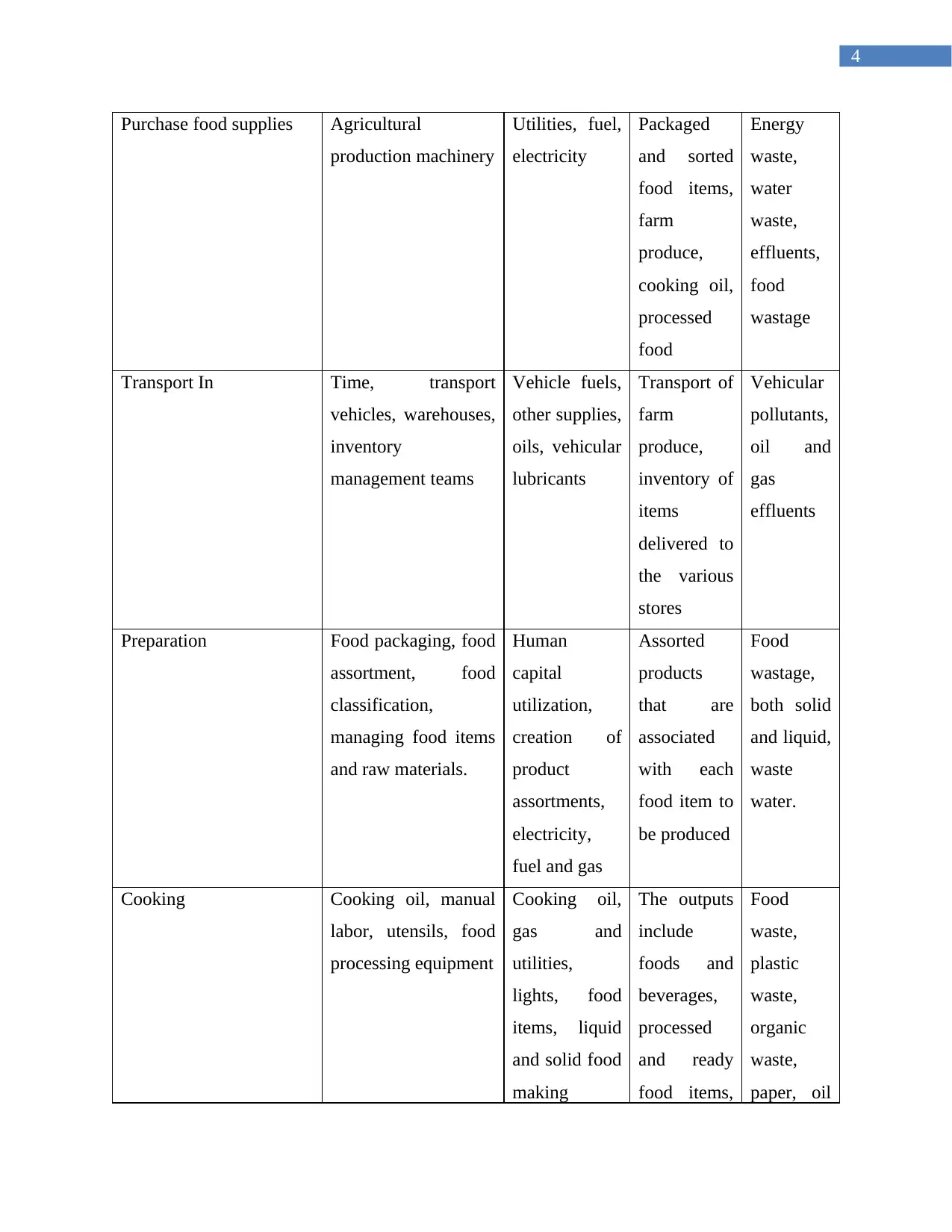
4
Purchase food supplies Agricultural
production machinery
Utilities, fuel,
electricity
Packaged
and sorted
food items,
farm
produce,
cooking oil,
processed
food
Energy
waste,
water
waste,
effluents,
food
wastage
Transport In Time, transport
vehicles, warehouses,
inventory
management teams
Vehicle fuels,
other supplies,
oils, vehicular
lubricants
Transport of
farm
produce,
inventory of
items
delivered to
the various
stores
Vehicular
pollutants,
oil and
gas
effluents
Preparation Food packaging, food
assortment, food
classification,
managing food items
and raw materials.
Human
capital
utilization,
creation of
product
assortments,
electricity,
fuel and gas
Assorted
products
that are
associated
with each
food item to
be produced
Food
wastage,
both solid
and liquid,
waste
water.
Cooking Cooking oil, manual
labor, utensils, food
processing equipment
Cooking oil,
gas and
utilities,
lights, food
items, liquid
and solid food
making
The outputs
include
foods and
beverages,
processed
and ready
food items,
Food
waste,
plastic
waste,
organic
waste,
paper, oil
Purchase food supplies Agricultural
production machinery
Utilities, fuel,
electricity
Packaged
and sorted
food items,
farm
produce,
cooking oil,
processed
food
Energy
waste,
water
waste,
effluents,
food
wastage
Transport In Time, transport
vehicles, warehouses,
inventory
management teams
Vehicle fuels,
other supplies,
oils, vehicular
lubricants
Transport of
farm
produce,
inventory of
items
delivered to
the various
stores
Vehicular
pollutants,
oil and
gas
effluents
Preparation Food packaging, food
assortment, food
classification,
managing food items
and raw materials.
Human
capital
utilization,
creation of
product
assortments,
electricity,
fuel and gas
Assorted
products
that are
associated
with each
food item to
be produced
Food
wastage,
both solid
and liquid,
waste
water.
Cooking Cooking oil, manual
labor, utensils, food
processing equipment
Cooking oil,
gas and
utilities,
lights, food
items, liquid
and solid food
making
The outputs
include
foods and
beverages,
processed
and ready
food items,
Food
waste,
plastic
waste,
organic
waste,
paper, oil
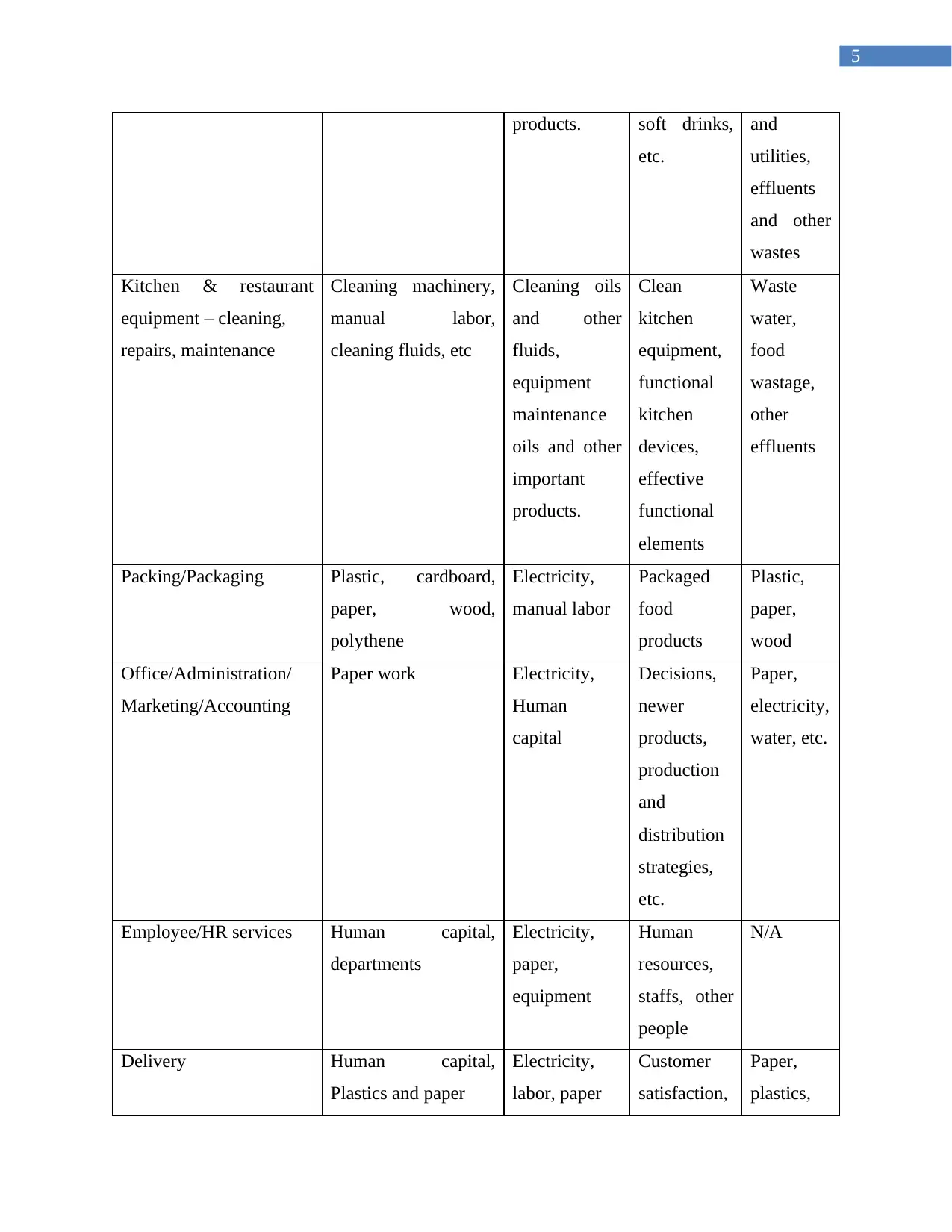
5
products. soft drinks,
etc.
and
utilities,
effluents
and other
wastes
Kitchen & restaurant
equipment – cleaning,
repairs, maintenance
Cleaning machinery,
manual labor,
cleaning fluids, etc
Cleaning oils
and other
fluids,
equipment
maintenance
oils and other
important
products.
Clean
kitchen
equipment,
functional
kitchen
devices,
effective
functional
elements
Waste
water,
food
wastage,
other
effluents
Packing/Packaging Plastic, cardboard,
paper, wood,
polythene
Electricity,
manual labor
Packaged
food
products
Plastic,
paper,
wood
Office/Administration/
Marketing/Accounting
Paper work Electricity,
Human
capital
Decisions,
newer
products,
production
and
distribution
strategies,
etc.
Paper,
electricity,
water, etc.
Employee/HR services Human capital,
departments
Electricity,
paper,
equipment
Human
resources,
staffs, other
people
N/A
Delivery Human capital,
Plastics and paper
Electricity,
labor, paper
Customer
satisfaction,
Paper,
plastics,
products. soft drinks,
etc.
and
utilities,
effluents
and other
wastes
Kitchen & restaurant
equipment – cleaning,
repairs, maintenance
Cleaning machinery,
manual labor,
cleaning fluids, etc
Cleaning oils
and other
fluids,
equipment
maintenance
oils and other
important
products.
Clean
kitchen
equipment,
functional
kitchen
devices,
effective
functional
elements
Waste
water,
food
wastage,
other
effluents
Packing/Packaging Plastic, cardboard,
paper, wood,
polythene
Electricity,
manual labor
Packaged
food
products
Plastic,
paper,
wood
Office/Administration/
Marketing/Accounting
Paper work Electricity,
Human
capital
Decisions,
newer
products,
production
and
distribution
strategies,
etc.
Paper,
electricity,
water, etc.
Employee/HR services Human capital,
departments
Electricity,
paper,
equipment
Human
resources,
staffs, other
people
N/A
Delivery Human capital,
Plastics and paper
Electricity,
labor, paper
Customer
satisfaction,
Paper,
plastics,
⊘ This is a preview!⊘
Do you want full access?
Subscribe today to unlock all pages.

Trusted by 1+ million students worldwide
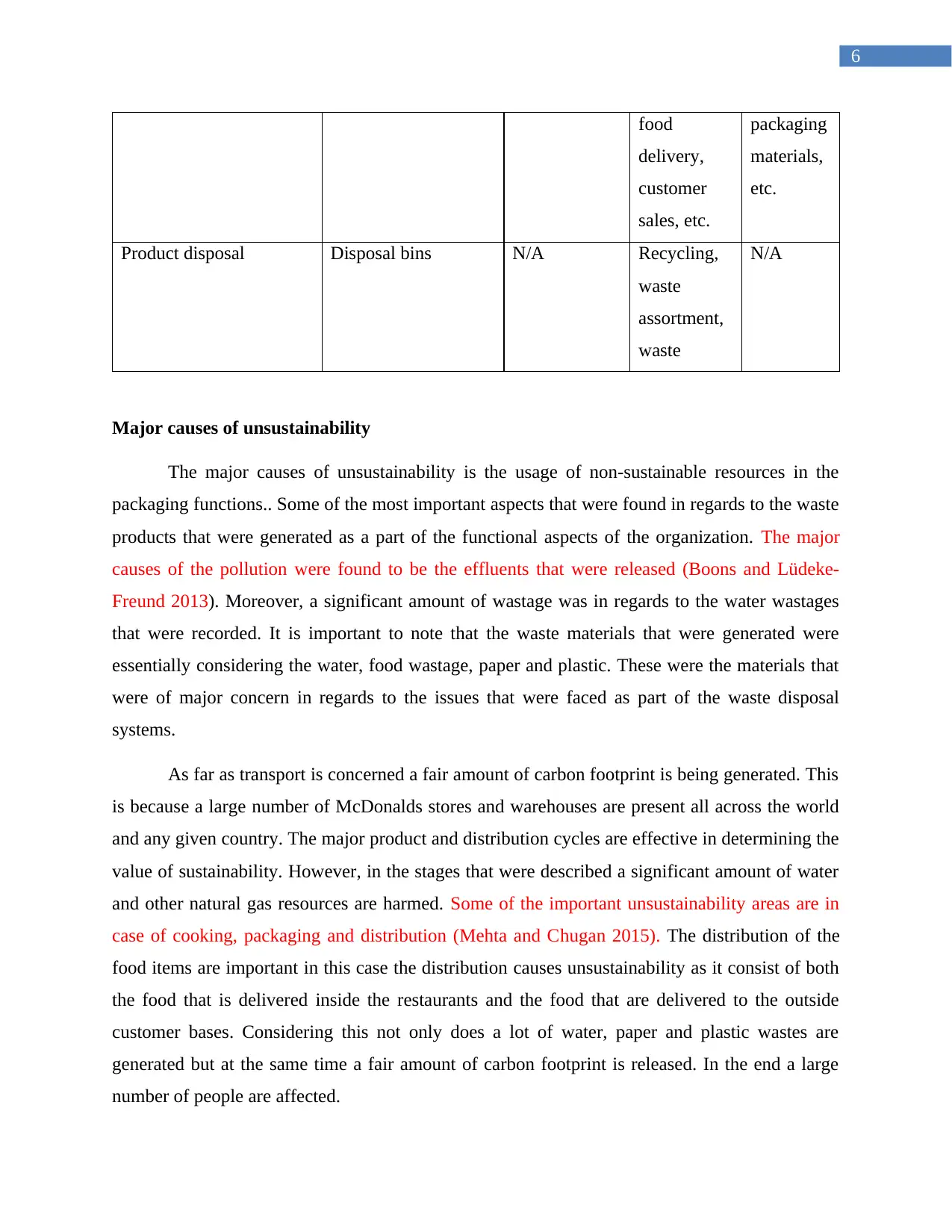
6
food
delivery,
customer
sales, etc.
packaging
materials,
etc.
Product disposal Disposal bins N/A Recycling,
waste
assortment,
waste
N/A
Major causes of unsustainability
The major causes of unsustainability is the usage of non-sustainable resources in the
packaging functions.. Some of the most important aspects that were found in regards to the waste
products that were generated as a part of the functional aspects of the organization. The major
causes of the pollution were found to be the effluents that were released (Boons and Lüdeke-
Freund 2013). Moreover, a significant amount of wastage was in regards to the water wastages
that were recorded. It is important to note that the waste materials that were generated were
essentially considering the water, food wastage, paper and plastic. These were the materials that
were of major concern in regards to the issues that were faced as part of the waste disposal
systems.
As far as transport is concerned a fair amount of carbon footprint is being generated. This
is because a large number of McDonalds stores and warehouses are present all across the world
and any given country. The major product and distribution cycles are effective in determining the
value of sustainability. However, in the stages that were described a significant amount of water
and other natural gas resources are harmed. Some of the important unsustainability areas are in
case of cooking, packaging and distribution (Mehta and Chugan 2015). The distribution of the
food items are important in this case the distribution causes unsustainability as it consist of both
the food that is delivered inside the restaurants and the food that are delivered to the outside
customer bases. Considering this not only does a lot of water, paper and plastic wastes are
generated but at the same time a fair amount of carbon footprint is released. In the end a large
number of people are affected.
food
delivery,
customer
sales, etc.
packaging
materials,
etc.
Product disposal Disposal bins N/A Recycling,
waste
assortment,
waste
N/A
Major causes of unsustainability
The major causes of unsustainability is the usage of non-sustainable resources in the
packaging functions.. Some of the most important aspects that were found in regards to the waste
products that were generated as a part of the functional aspects of the organization. The major
causes of the pollution were found to be the effluents that were released (Boons and Lüdeke-
Freund 2013). Moreover, a significant amount of wastage was in regards to the water wastages
that were recorded. It is important to note that the waste materials that were generated were
essentially considering the water, food wastage, paper and plastic. These were the materials that
were of major concern in regards to the issues that were faced as part of the waste disposal
systems.
As far as transport is concerned a fair amount of carbon footprint is being generated. This
is because a large number of McDonalds stores and warehouses are present all across the world
and any given country. The major product and distribution cycles are effective in determining the
value of sustainability. However, in the stages that were described a significant amount of water
and other natural gas resources are harmed. Some of the important unsustainability areas are in
case of cooking, packaging and distribution (Mehta and Chugan 2015). The distribution of the
food items are important in this case the distribution causes unsustainability as it consist of both
the food that is delivered inside the restaurants and the food that are delivered to the outside
customer bases. Considering this not only does a lot of water, paper and plastic wastes are
generated but at the same time a fair amount of carbon footprint is released. In the end a large
number of people are affected.
Paraphrase This Document
Need a fresh take? Get an instant paraphrase of this document with our AI Paraphraser
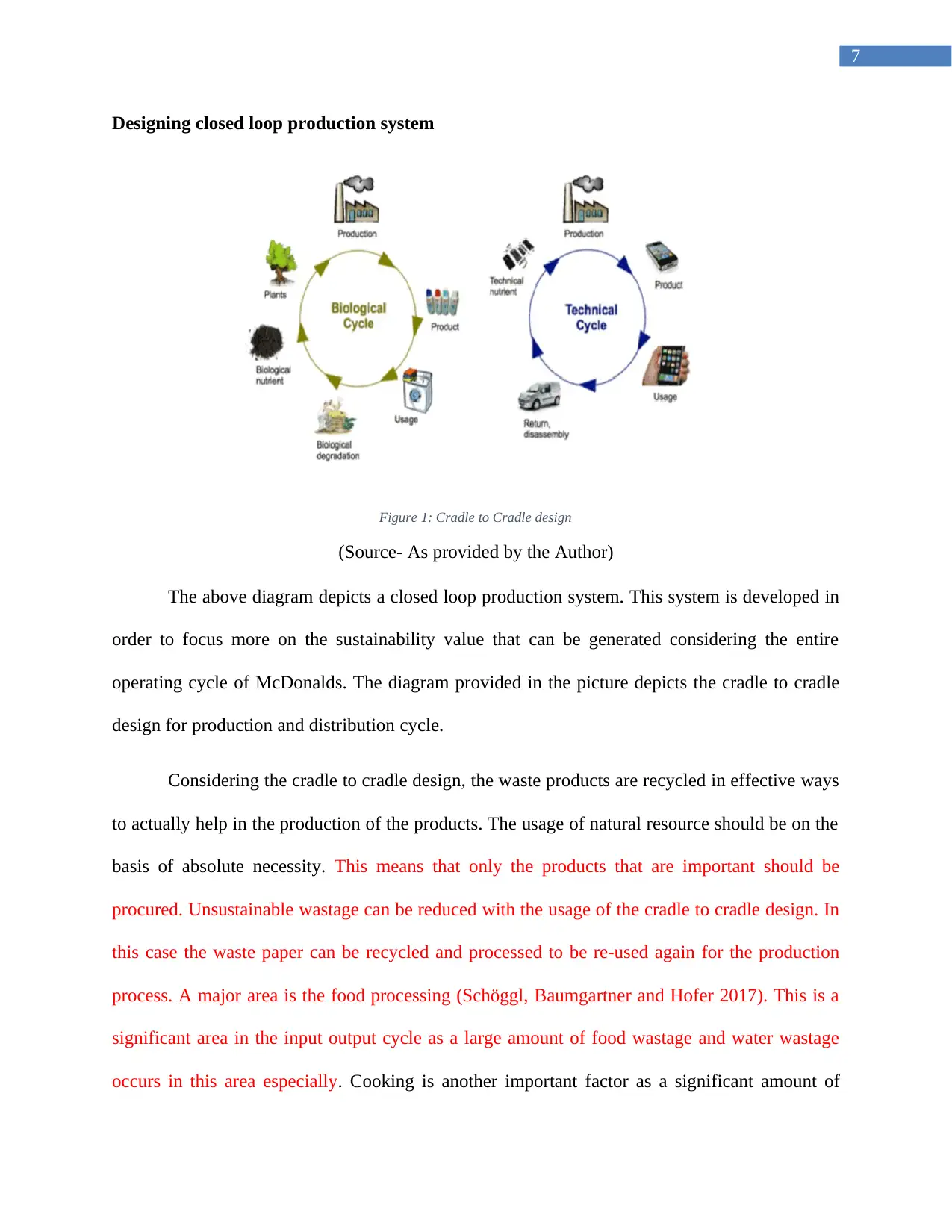
7
Designing closed loop production system
Figure 1: Cradle to Cradle design
(Source- As provided by the Author)
The above diagram depicts a closed loop production system. This system is developed in
order to focus more on the sustainability value that can be generated considering the entire
operating cycle of McDonalds. The diagram provided in the picture depicts the cradle to cradle
design for production and distribution cycle.
Considering the cradle to cradle design, the waste products are recycled in effective ways
to actually help in the production of the products. The usage of natural resource should be on the
basis of absolute necessity. This means that only the products that are important should be
procured. Unsustainable wastage can be reduced with the usage of the cradle to cradle design. In
this case the waste paper can be recycled and processed to be re-used again for the production
process. A major area is the food processing (Schöggl, Baumgartner and Hofer 2017). This is a
significant area in the input output cycle as a large amount of food wastage and water wastage
occurs in this area especially. Cooking is another important factor as a significant amount of
Designing closed loop production system
Figure 1: Cradle to Cradle design
(Source- As provided by the Author)
The above diagram depicts a closed loop production system. This system is developed in
order to focus more on the sustainability value that can be generated considering the entire
operating cycle of McDonalds. The diagram provided in the picture depicts the cradle to cradle
design for production and distribution cycle.
Considering the cradle to cradle design, the waste products are recycled in effective ways
to actually help in the production of the products. The usage of natural resource should be on the
basis of absolute necessity. This means that only the products that are important should be
procured. Unsustainable wastage can be reduced with the usage of the cradle to cradle design. In
this case the waste paper can be recycled and processed to be re-used again for the production
process. A major area is the food processing (Schöggl, Baumgartner and Hofer 2017). This is a
significant area in the input output cycle as a large amount of food wastage and water wastage
occurs in this area especially. Cooking is another important factor as a significant amount of
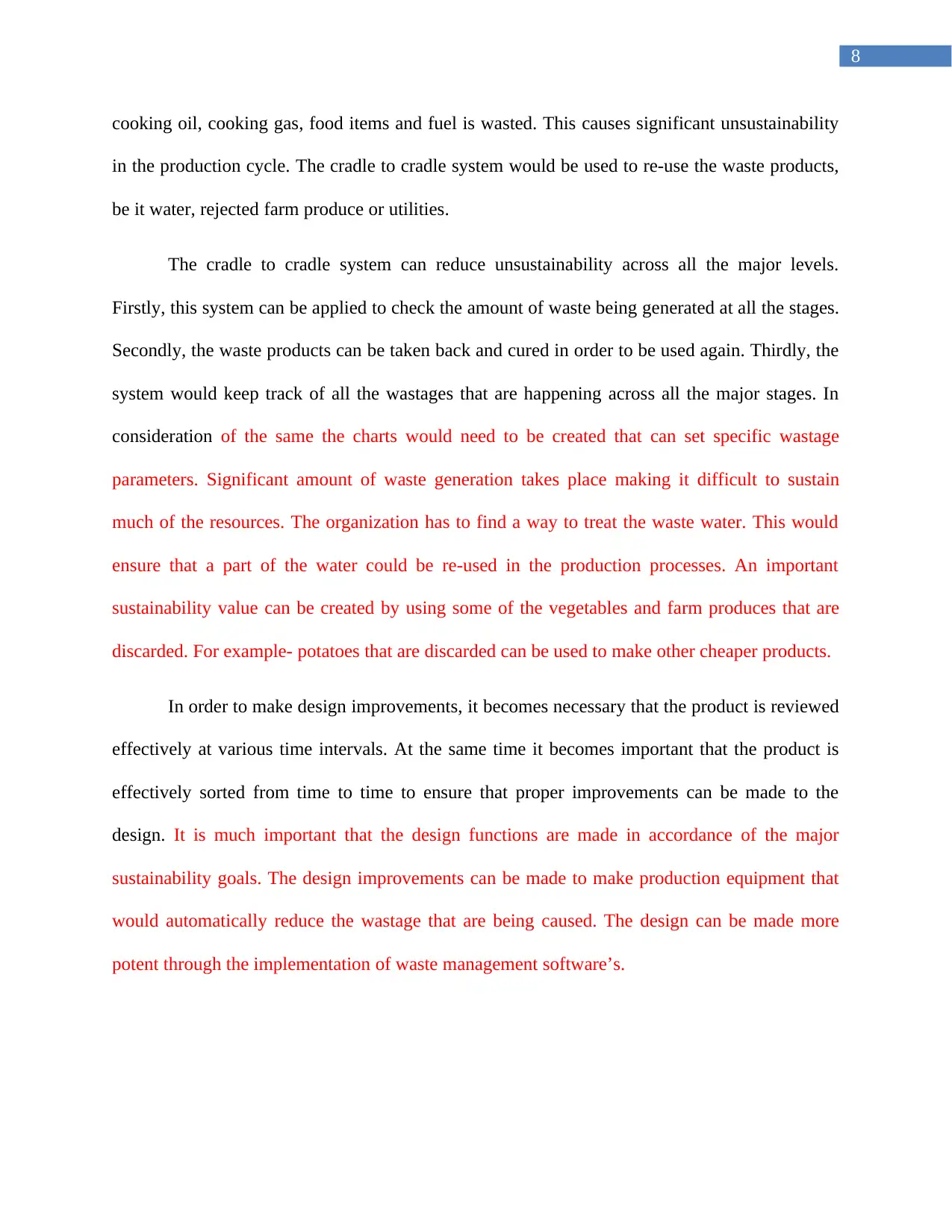
8
cooking oil, cooking gas, food items and fuel is wasted. This causes significant unsustainability
in the production cycle. The cradle to cradle system would be used to re-use the waste products,
be it water, rejected farm produce or utilities.
The cradle to cradle system can reduce unsustainability across all the major levels.
Firstly, this system can be applied to check the amount of waste being generated at all the stages.
Secondly, the waste products can be taken back and cured in order to be used again. Thirdly, the
system would keep track of all the wastages that are happening across all the major stages. In
consideration of the same the charts would need to be created that can set specific wastage
parameters. Significant amount of waste generation takes place making it difficult to sustain
much of the resources. The organization has to find a way to treat the waste water. This would
ensure that a part of the water could be re-used in the production processes. An important
sustainability value can be created by using some of the vegetables and farm produces that are
discarded. For example- potatoes that are discarded can be used to make other cheaper products.
In order to make design improvements, it becomes necessary that the product is reviewed
effectively at various time intervals. At the same time it becomes important that the product is
effectively sorted from time to time to ensure that proper improvements can be made to the
design. It is much important that the design functions are made in accordance of the major
sustainability goals. The design improvements can be made to make production equipment that
would automatically reduce the wastage that are being caused. The design can be made more
potent through the implementation of waste management software’s.
cooking oil, cooking gas, food items and fuel is wasted. This causes significant unsustainability
in the production cycle. The cradle to cradle system would be used to re-use the waste products,
be it water, rejected farm produce or utilities.
The cradle to cradle system can reduce unsustainability across all the major levels.
Firstly, this system can be applied to check the amount of waste being generated at all the stages.
Secondly, the waste products can be taken back and cured in order to be used again. Thirdly, the
system would keep track of all the wastages that are happening across all the major stages. In
consideration of the same the charts would need to be created that can set specific wastage
parameters. Significant amount of waste generation takes place making it difficult to sustain
much of the resources. The organization has to find a way to treat the waste water. This would
ensure that a part of the water could be re-used in the production processes. An important
sustainability value can be created by using some of the vegetables and farm produces that are
discarded. For example- potatoes that are discarded can be used to make other cheaper products.
In order to make design improvements, it becomes necessary that the product is reviewed
effectively at various time intervals. At the same time it becomes important that the product is
effectively sorted from time to time to ensure that proper improvements can be made to the
design. It is much important that the design functions are made in accordance of the major
sustainability goals. The design improvements can be made to make production equipment that
would automatically reduce the wastage that are being caused. The design can be made more
potent through the implementation of waste management software’s.
⊘ This is a preview!⊘
Do you want full access?
Subscribe today to unlock all pages.

Trusted by 1+ million students worldwide
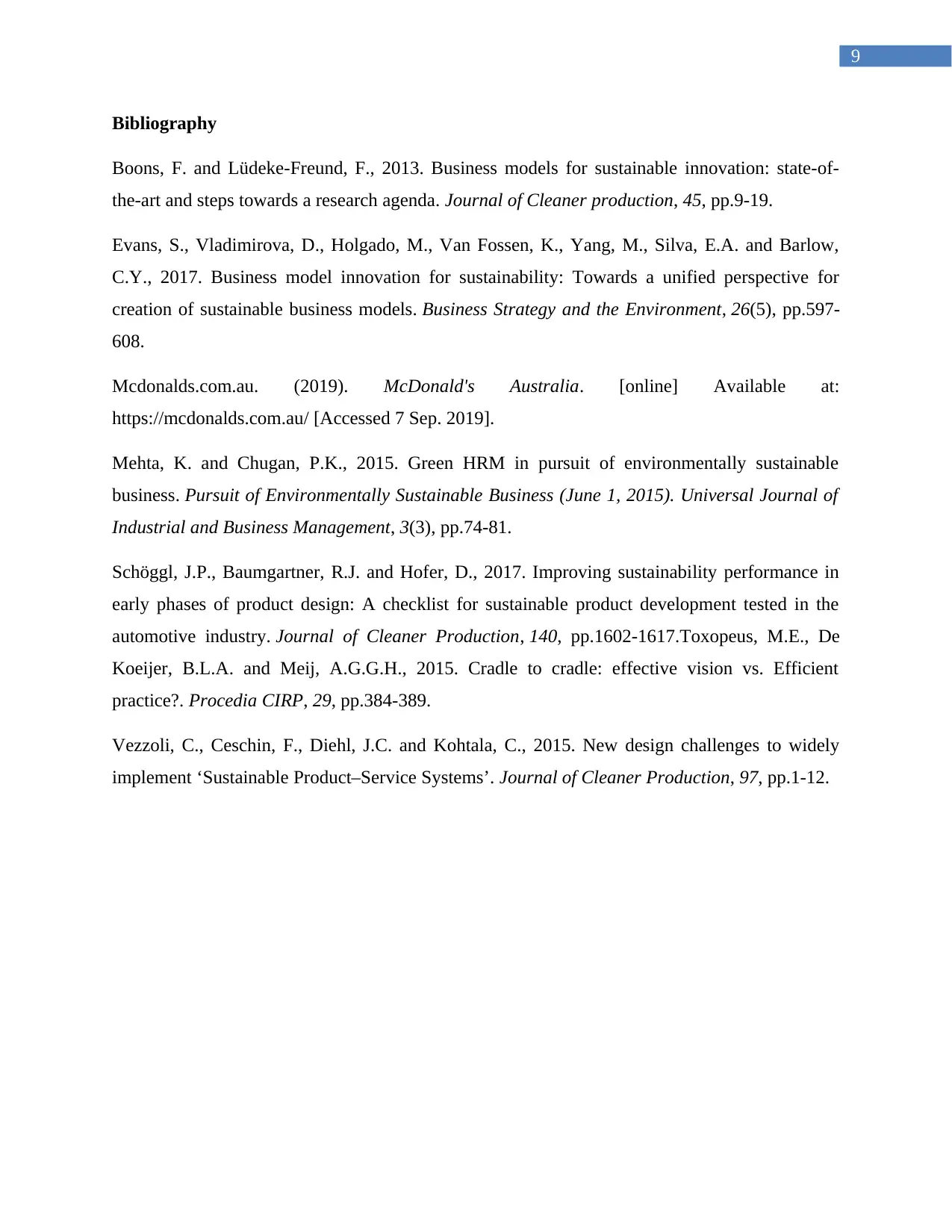
9
Bibliography
Boons, F. and Lüdeke-Freund, F., 2013. Business models for sustainable innovation: state-of-
the-art and steps towards a research agenda. Journal of Cleaner production, 45, pp.9-19.
Evans, S., Vladimirova, D., Holgado, M., Van Fossen, K., Yang, M., Silva, E.A. and Barlow,
C.Y., 2017. Business model innovation for sustainability: Towards a unified perspective for
creation of sustainable business models. Business Strategy and the Environment, 26(5), pp.597-
608.
Mcdonalds.com.au. (2019). McDonald's Australia. [online] Available at:
https://mcdonalds.com.au/ [Accessed 7 Sep. 2019].
Mehta, K. and Chugan, P.K., 2015. Green HRM in pursuit of environmentally sustainable
business. Pursuit of Environmentally Sustainable Business (June 1, 2015). Universal Journal of
Industrial and Business Management, 3(3), pp.74-81.
Schöggl, J.P., Baumgartner, R.J. and Hofer, D., 2017. Improving sustainability performance in
early phases of product design: A checklist for sustainable product development tested in the
automotive industry. Journal of Cleaner Production, 140, pp.1602-1617.Toxopeus, M.E., De
Koeijer, B.L.A. and Meij, A.G.G.H., 2015. Cradle to cradle: effective vision vs. Efficient
practice?. Procedia CIRP, 29, pp.384-389.
Vezzoli, C., Ceschin, F., Diehl, J.C. and Kohtala, C., 2015. New design challenges to widely
implement ‘Sustainable Product–Service Systems’. Journal of Cleaner Production, 97, pp.1-12.
Bibliography
Boons, F. and Lüdeke-Freund, F., 2013. Business models for sustainable innovation: state-of-
the-art and steps towards a research agenda. Journal of Cleaner production, 45, pp.9-19.
Evans, S., Vladimirova, D., Holgado, M., Van Fossen, K., Yang, M., Silva, E.A. and Barlow,
C.Y., 2017. Business model innovation for sustainability: Towards a unified perspective for
creation of sustainable business models. Business Strategy and the Environment, 26(5), pp.597-
608.
Mcdonalds.com.au. (2019). McDonald's Australia. [online] Available at:
https://mcdonalds.com.au/ [Accessed 7 Sep. 2019].
Mehta, K. and Chugan, P.K., 2015. Green HRM in pursuit of environmentally sustainable
business. Pursuit of Environmentally Sustainable Business (June 1, 2015). Universal Journal of
Industrial and Business Management, 3(3), pp.74-81.
Schöggl, J.P., Baumgartner, R.J. and Hofer, D., 2017. Improving sustainability performance in
early phases of product design: A checklist for sustainable product development tested in the
automotive industry. Journal of Cleaner Production, 140, pp.1602-1617.Toxopeus, M.E., De
Koeijer, B.L.A. and Meij, A.G.G.H., 2015. Cradle to cradle: effective vision vs. Efficient
practice?. Procedia CIRP, 29, pp.384-389.
Vezzoli, C., Ceschin, F., Diehl, J.C. and Kohtala, C., 2015. New design challenges to widely
implement ‘Sustainable Product–Service Systems’. Journal of Cleaner Production, 97, pp.1-12.
1 out of 10
Related Documents
Your All-in-One AI-Powered Toolkit for Academic Success.
+13062052269
info@desklib.com
Available 24*7 on WhatsApp / Email
![[object Object]](/_next/static/media/star-bottom.7253800d.svg)
Unlock your academic potential
Copyright © 2020–2025 A2Z Services. All Rights Reserved. Developed and managed by ZUCOL.





